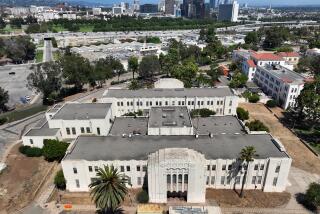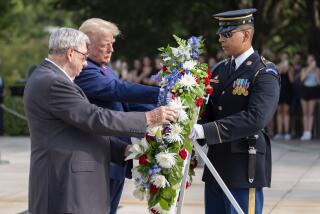National Cemeteries for Veterans Short on Space : Interment: Fifty-six of 114 have no more grave sites available, and the rest are filling rapidly. Finding additional space, officials say, is a challenge.
- Share via
WASHINGTON — National cemeteries, where more than 2 million American veterans and dependents are buried, are running out of space.
Fifty-six of the 114 national cemeteries administered by the Department of Veterans Affairs already have exhausted available grave sites. Others are filling rapidly as the remaining 8 million World War II veterans age and die.
“We expect to have to close one cemetery a year for the next three years,” spokesman Rick Arndt of the VA’s national cemetery system said. “Several more are projected to close before the year 2000.”
Finding additional space, officials say, is a challenge second only to creating the first “cemetery grounds” for the hundreds of thousands of Union soldiers killed during the Civil War.
About 2.04 million American veterans and dependents have been buried in VA-administered national cemeteries in the ensuing 133 years.
Thousands more have been interred in Arlington National Cemetery and the Soldiers’ and Airmen’s Home, both managed by the Army in the Washington area.
Fourteen other national cemeteries are maintained by the Department of the Interior, such as Gettysburg and others closely associated with national battlefields.
Arndt says the VA’s National Cemetery System has space available for only 230,000 more caskets and the cremated remains of 50,000 other servicemen and women, although it owns land that could be developed for another 1.6 million grave sites.
There are nearly 27 million eligible veterans, many of whom are expected to be buried in national cemeteries.
The VA is developing new cemeteries near Seattle, Albany, N.Y., and Dallas and hopes to create additional sites soon near Cleveland, Chicago and Oklahoma City.
The first 14 national cemeteries were created in 1862 when Congress authorized President Abraham Lincoln to purchase sites “for soldiers who shall have died in the service of the country.”
By 1870, the remains of nearly 300,000 Union dead had been buried in 73 cemeteries, most in the Southeast near Civil War battlefields and campgrounds. In 1873, the cemeteries were opened to all honorably discharged U.S. veterans.
Then, as the nation moved West, national cemeteries associated with military posts were created. Today, the cemeteries contain the remains of veterans of every war and conflict, ranging from the Revolutionary War to the Persian Gulf War.
National cemeteries occupy more than 11,000 acres from Maine to Hawaii and from Alaska to Puerto Rico. In addition, the American Battle Monuments Commission created after World War I administers 24 burial grounds in foreign countries.
National cemeteries that still have space generally are open to veterans who have been killed in action or honorably discharged from active duty and, in many cases, their spouses and dependent children. In recent years, about one-fourth of the more than 68,000 burials each year have been those of dependents.
Grave sites may not be reserved. Families seeking burial sites should contact the nearest national cemetery or VA regional office.
Grave sites and grave liners are provided free. In addition, the VA prepares and closes the graves, furnishes headstones or markers, and provides perpetual care.
The VA also drapes caskets with American flags, which then are given to the families. Memorial certificates bearing the President’s signature and expressing the nation’s recognition of the deceased’s service are available.
While the VA does not furnish military honors, cemetery superintendents usually can provide sources for such ceremonies.
More to Read
Sign up for Essential California
The most important California stories and recommendations in your inbox every morning.
You may occasionally receive promotional content from the Los Angeles Times.













